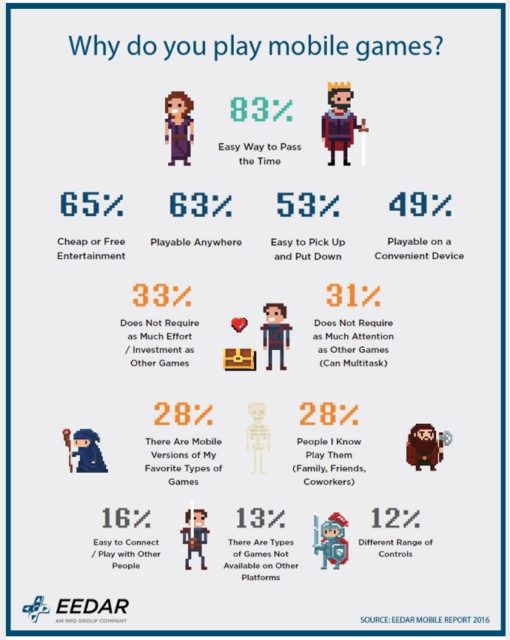It may be too late to stuff your face with turkey, but we’re here with a heaping helping of marketing stats to chow down on. This week, we take a look at how consumers view and recognize ads, what’s important to affluent millennials, and what’s shakin’ and bakin’ in the video games world.
Trust Me, I’m An Ad
Over the years, there has been a significant shift in how consumers view and interact with advertising. People rely on the advice of their peers over experts and trust influencers over traditional celebrity spokespeople. A report by Olapic revealed that when it comes to choosing a photo for your ad, “real people” are trusted seven times more than a stock photo or “Photoshopped” image. The report details the results of more than 4,500 active social media users between ages 16 and 49 in the US and the UK, France, Germany, Spain and Sweden in which 56 percent said they would be more likely to click on an ad that features user-generated content like a selfie over other types of advertising, and more inclined to purchase, as well.
But you know it’s an ad, right? If you’re a pre-teen or teenager in the US, you might not be able to tell the difference. An incredible 82 percent of middle-schoolers couldn’t distinguish between an ad labeled “sponsored content” and a real news story on a website, according to a Stanford University study of 7,804 students from middle school through college.
Nearly four in 10 high-school students believed, based on the headline, that a photo of deformed daisies on a photo-sharing site provided strong evidence of toxic conditions near the Fukushima Daiichi nuclear plant in Japan, even though no source or location was given for the photo. No wonder sites like Facebook and Google are cracking down on fake content!

When it comes to remembering which ads you’ve seen, awareness for almost half of the major retail brands is significantly down since last year. According to YouGov BrandIndex, Walmart is number one for brand awareness this holiday season but Amazon is ranked first in value by consumers. Kmart and Best Buy suffered the largest ad awareness losses since 2015’s Black Friday, YouGov reports, with drops of 12 points and 10 points respectively.
Of course, it’s easier to remember an ad if it’s targeted to the right consumer. Mobile ad targeting is getting more accurate, according to Nielson’s Digital Ads Benchmarks and Findings report, with 60 percent of mobile ad impressions viewed by people of the age and gender intended by advertisers. This number is up from 49 percent in the same period of 2015.
“This now puts the average on-target percentage for mobile campaigns on par with that of desktop campaigns—a factor that could influence considerations of media buyers and sellers planning digital media campaigns,” the report said.
Mobile users see a lot more ads, too. While ad blocking is on the rise, a study by AudienceProject found that while 26 percent of respondents in the UK and 23 percent in the US used an ad blocker on their desktops, only two percent in both countries use ad blocking tools on their smartphones. Among the ad blockers in UK, 34 percent say that their attitude toward ads would be affected in a positive way if the ads displayed relevant messages, with 44 percent feeling the same way in the US.
Programmatic ad spending is growing in popularity and Zenith predicts that the method will grow 31 percent next year. “Programmatic buying of digital media has become the norm in major markets, and is aggressively following this path in smaller markets,” said Benoit Cacheux, global head of digital and innovation at Zenith. The Programmatic Marketing Forecasts report predicts that social spending will grow by 25 percent and online video will expand by 20 percent, with a growing proportion of these other channels will be traded programmatically by the year’s end.
Branding Is Life For Affluent Millennials
Nearly three-quarters (70 percent) of affluent millennial internet users said their favorite brands play an integral role in their life, according to a survey from BBC Advertising. While 51 percent of non-affluent millennials felt the same way, there is a significant drop in whether or not brands define one’s person. For affluent millennials, 60 percent said that they are defined by the brands they purchase, compared to 44 percent of those not considered affluent.

Gamers Gotta Game . . .
. . . and a whole lot of them are catching “pocket monsters” right now. Pokémon Sun and Moon are now the best-selling video games in online holiday shopping in the US so far, and the fastest-selling title to be sold in the US by Nintendo.
Chances are, if someone in your home isn’t off exploring Alola, someone is probably watching eSports instead. A new study by research company Leger found that 25 percent of US Adults have someone in the household who has watched an eSports tournament. People are watching more, lately, too—the study shows a boost in viewership over the past six months, with the level of adults who watched an eSports event increasing from 15 percent to 18 percent between May and October, while overall household viewership grew from 22 percent to 25 percent.
And yet someone else in the home is probably matching candies or something on their mobile phones. According to a new study by Eedar, 83 percent of participants said they play mobile games because it’s an easy way to pass the time.

October’s digital game market experienced 14 percent year-over-year growth, according to SuperData, with $6.7 billion in total October revenue. New major releases including Battlefield 1, Titanfall 2, Mafia 3 and Gears of War 4 helped propel Console digital revenue to $628 million, a 27 percent year-over-year increase.
Premium PC experienced the greatest growth of any segment, however, jumping 78 percent to $592 million in revenue, which SuperData attributes to the strong performance of Civilization VI, a PC-exclusive title. Mobile gaming continues to grow steadily, with revenue increasing 15 percent year-over-year to $3.1 billion.
SuperData’s Top-Selling games for October are:
PC
- League of Legends
- Crossfire
- World of Warcraft
- Dungeon Fighter Online
- Sid Meier’s Civilization VI
- Overwatch
- Battlefield 1
- DOTA 2
- World of Tanks
- Fantasy Westward Journey Online II
Console
- Battlefield 1
- FIFA 17
- Mafia III
- Call of Duty: Black Ops III
- Grand Theft Auto V
- NBA 2K17
- Destiny
- Gears of War 4
- FIFA 16
- Star Wars Battlefront
Mobile
- Pokémon Go
- Clash Royale
- Monster Strike
- Clash of Clans
- Mobile Strike
- Game of War: Fire Age
- Fantasy Westward Journey
- Candy Crush Saga
- Puzzles & Dragons
- Clash of Kings
Learn everything you need to know to invest in today’s fastest-growing media channel—Competitive Gaming and eSports on 2.16.17 in Los Angeles. Go to alistsummit.com for more info.

